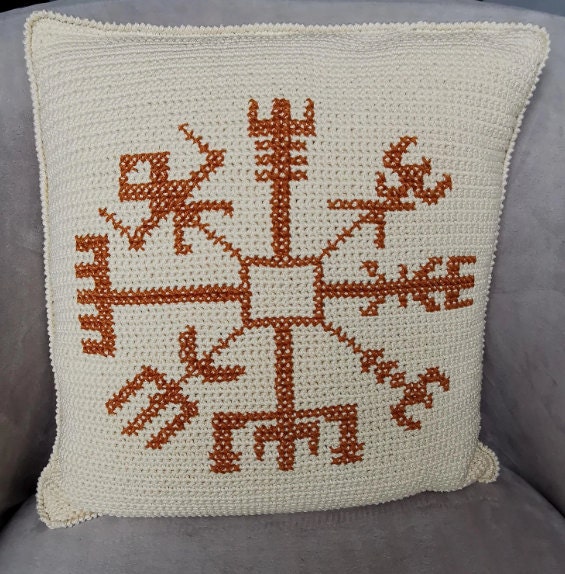The first recorded mention of the Vegvísir appears in the Huld Manuscript, an Icelandic collection of symbols and magical runes compiled in 1860 by Geir Vigfússon. This manuscript, which contains various staves (magical symbols), describes the Vegvísir as a tool that ensures the bearer "will never lose their way in storms or bad weather, even when the way is not known."Despite its presence in 19th-century Icelandic texts, there is no concrete evidence that the Vikings used the Vegvísir. However, Icelandic culture has deep roots in Viking traditions, and many of its mystical symbols and runes are inspired by Norse beliefs. This has led some historians and enthusiasts to speculate that the Vegvísir might have been based on older Viking-era practices or beliefs regarding navigation and magic.
The word "Vegvísir" translates from Icelandic as "wayfinder" or "signpost." The symbol itself consists of eight arms radiating outward from a central point, resembling a compass rose. Each arm is adorned with runic-like inscriptions, which some believe represent different elements of navigation, protection, or spiritual guidance.While the exact meaning of each segment remains uncertain, the general interpretation is that the Vegvísir serves as a guide, helping those who carry it to find their way physically, emotionally, and spiritually. Many modern practitioners of Norse-inspired spirituality view the Vegvísir as a talisman for overcoming life’s obstacles and staying on the right path, much like a compass guiding a lost traveler.
Even though there is no direct link between the Vegvísir and Viking navigation tools, it is worth exploring how the Norse navigated the seas. The Vikings were remarkable seafarers who traveled vast distances using natural indicators such as the sun, stars, wind patterns, and ocean currents. They also employed tools like the sunstone, a type of crystal that helped them locate the sun even on cloudy days.Some researchers have suggested that symbols like the Vegvísir could have been inspired by the Vikings’ advanced understanding of navigation. Although it is unlikely that the Vegvísir itself was used in Viking voyages, the idea of a guiding symbol aligns with teir seafaring legacy.
In recent years, the Vegvísir has experienced a resurgence in popularity, especially among those interested in Norse mythology, Viking culture, and pagan spirituality. It is frequently seen in tattoos, jewelry, and artwork, often symbolizing personal strength, protection, and direction in life.Many people who get a Vegvísir tattoo or wear it as an amulet believe that it will help them stay true to their path and navigate challenges. It has also become a popular symbol within the modern pagan movement, particularly among followers of Ásatrú, a contemporary revival of Norse religious traditions.The Vegvísir is also found in pop culture, appearing in movies, video games, and TV shows that draw inspiration from Norse mythology. This exposure has contributed to its growing recognition worldwide, even among those who have little knowledge of its origins.
Despite its widespread use, the Vegvísir is sometimes misunderstood. Because it is often called the "Viking compass," many assume it was a common Viking-era tool, when in reality, its first documented appearance was much later. Some critics argue that attributing the Vegvísir to the Vikings without sufficient historical evidence is misleading.Another debate revolves around its meaning. Since the Huld Manuscript does not provide an in-depth explanation of the symbol, interpretations vary. Some see it as a purely navigational aid, while others view it as a metaphor for spiritual or life guidance. The lack of definitive historical context allows for personal interpretations, which is part of its modern appeal.
Beyond its connection to navigation, many people consider the Vegvísir a spiritual emblem. In contemporary Norse paganism, it is often used in rituals and meditation as a symbol of protection and insight. Some believe that meditating on the Vegvísir can help one gain clarity and overcome obstacles in life.Others incorporate the Vegvísir into their daily lives as a reminder to stay focused on their goals. Whether it is seen as a mystical talisman or simply a motivational symbol, the Vegvísir’s association with guidance resonates deeply with those who use it.


